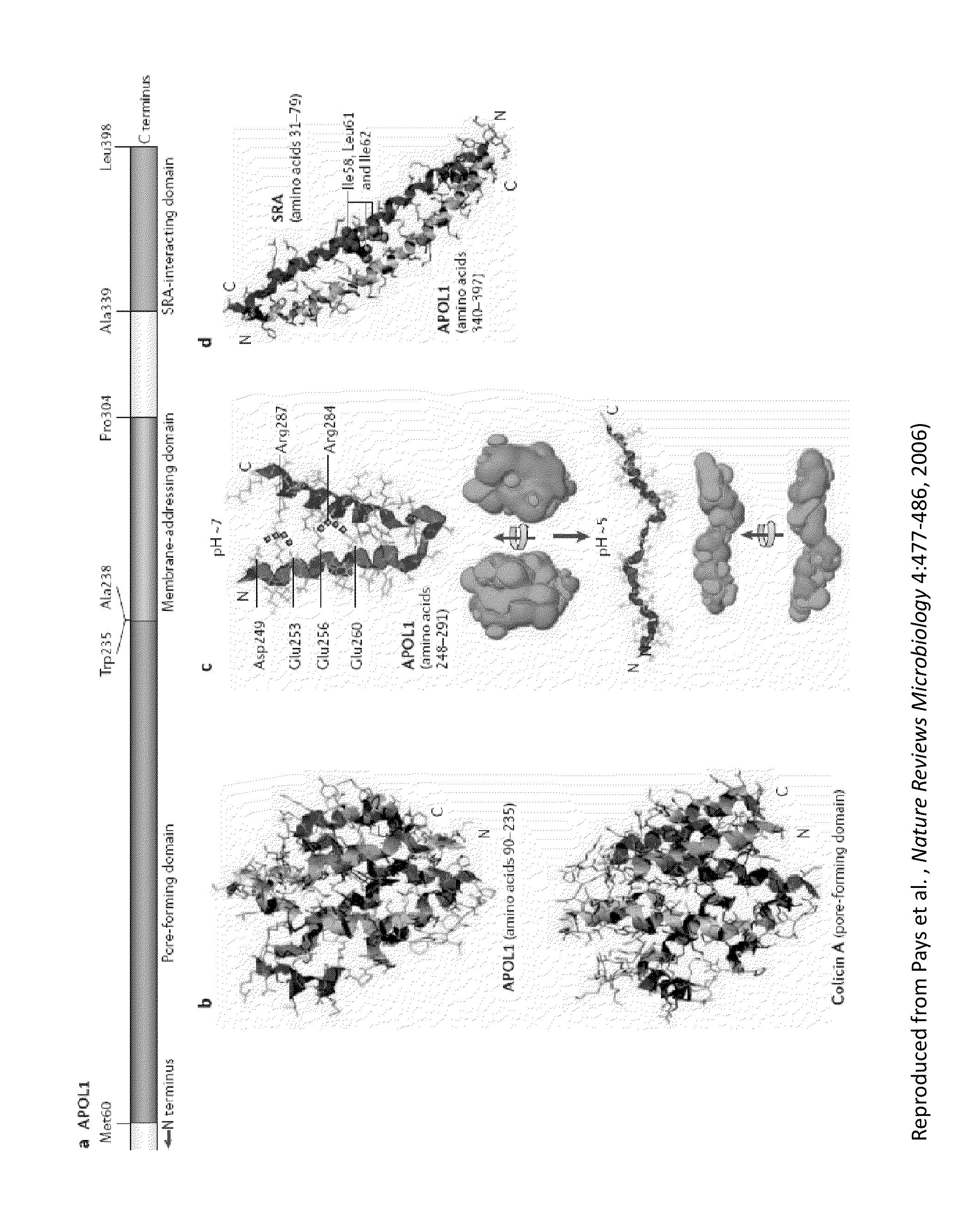Compositions and methods for treating renal disease
a technology for kidney disease and compositions, applied in the field of compositions and methods for treating renal disease, can solve the problems of no specific therapies, over 40 billion dollars per year spent on the care of patients with end-stage kidney failure, and inability to treat patients with eskd, so as to reduce the likelihood of renal disease development, reduce the deleterious effect of pathogenic apol1, and reduce the expression of apol1
- Summary
- Abstract
- Description
- Claims
- Application Information
AI Technical Summary
Benefits of technology
Problems solved by technology
Method used
Image
Examples
example 1
Biotherapeutic Readout in Clinic: Preclinical Read-Outs of Neutralization or Antagonism
[0177]Efficacy and physiological folding of common APOL1 can be tested by its ability to pull down recombinant SRA, the natural ligand expressed by T. brucei rhodesiense that confers human infectivity by binding ApoL1.
[0178]Preferably, an antibody of the invention is raised against an epitope in the SRA-binding region (amino acids 339-389 of SEQ ID NO: 2) that encompasses disease associated variant sequences (e.g., G1, G2, del6, and / or G3).
[0179]Preferred recombinant APOL1 proteins of the invention will bind to haptoglobin-related protein (HPR) and to the HPR-hemoglobin (Hb) complex (Vanhollebeke et al., Proceedings of the National Academy of Sciences of the United States of America 104:4118-4123, 2007).
[0180]The efficacy of monoclonal anti-APOL1 antibodies can be tested by standard techniques of ELISA, immunoblot, immunoprecipitation, immunohistochemistry, and immunofluorescence microscopy.
[0181]...
example 2
Biotherapeutic Readout in Clinic: In-Human Readout
[0183]In humans with two high risk APOL1 alleles, pharmacokinetics and stability of recombinant common APOL1 in the circulation can be confirmed by immunoreactivity to antibody that recognizes only common variant Apo-L1, but not Apo-L1 high risk variants.
[0184]In humans, recombinant SRA APOL1 binding domain can be measured by immunoassay.
[0185]Therapeutic efficacy upon administration of one or more of the compositions of the invention can be assessed by measuring changes (e.g., a decrease) in, e.g., proteinuria, which is a cardinal feature of renal disease and is easily measured, and / or changes in serum creatinine concentration.
example 3
Treatment of Renal Disease Patients that are Refractive to Other Therapies
[0186]African American patients with FSGS that do not respond to steroid treatment can be genotyped for APOL1 renal risk variants. Homozygous patients can be treated with one or more compositions of the invention described above (alone or in combination with one or more other therapeutic agents, such as a blood pressure medication, a steroid, and / or an immunosuppressive agent). Clinical readouts include urine protein and serum creatinine concentration levels. Since patients would have already failed first line therapy, differentiation from other therapies would be achievable.
PUM
| Property | Measurement | Unit |
|---|---|---|
| dissociation constant | aaaaa | aaaaa |
| dissociation constant | aaaaa | aaaaa |
| dissociation constant | aaaaa | aaaaa |
Abstract
Description
Claims
Application Information
 Login to View More
Login to View More - R&D
- Intellectual Property
- Life Sciences
- Materials
- Tech Scout
- Unparalleled Data Quality
- Higher Quality Content
- 60% Fewer Hallucinations
Browse by: Latest US Patents, China's latest patents, Technical Efficacy Thesaurus, Application Domain, Technology Topic, Popular Technical Reports.
© 2025 PatSnap. All rights reserved.Legal|Privacy policy|Modern Slavery Act Transparency Statement|Sitemap|About US| Contact US: help@patsnap.com

